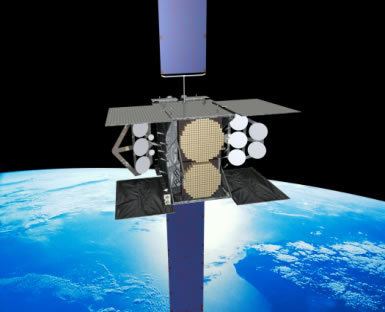Country of origin United States Design life 15 years | ||
 | ||
Manufacturer Boeing Defense, Space & Security Launch mass 1,500 kg (3,300 lb) to 6,100 kg (13,400 lb) Payload capacity 200 kg (440 lb) to 1,620 kg (3,570 lb) | ||
Boeing 702 is a family of communication satellite bus designed and manufactured by the Boeing Satellite Development Center. It covers satellites massing from 1,500 kg (3,300 lb) to 6,100 kg (13,400 lb) and with power outputs from 3 — 18 kW and can carry more than 100 high power transponders.
Contents
The baseline Boeing 702 is compatible with several orbital launch systems, including Atlas V, Ariane 5, Delta IV, Falcon 9, Proton, and Sea Launch operated Zenit 3SL.
Platform Versions
After the introduction of the original 702 in 1997, the platform has been continually updated. New members of the platform have been introduced through the years, which allowed the common systems and approaches to span the whole range of mass and power for geosynchronous orbit satellites. The family currently spans four different members: the 702HP for high power applications, the 702HP-GEO for mobile telephone services, the 702MP for medium power requirements and the 702SP for small satellites.
702HP
The high power 702 platform was originally announced in October 1998. With the 2009 introduction of the 702MP "mid-power version", the legacy Boeing 702 platform, which had been continuously evolved, was designated the Boeing 702HP for "high-power". According to Moog-ISP, the 702HP platform uses its bipropellant thrusters.
The SES-9, a 702HP model, launched aboard the Falcon 9 Flight 22 on 4 March 2016.
702 GEO-Mobile
Developed in 1997 for their launch customer, Thuraya, it is a special version of the 702HP platform with a 12.25-meter deployable antenna, onboard digital signal processing and beamforming. It is a specialized platform for direct service of mobile users.
702MP
In 2009 Boeing introduced the 702MP platform, a mid power solution based on the high power 702HP platform. The 702MP provides the high-capability features inherent in the flight-proven Boeing 702HP satellite model, but with a substantially updated satellite bus structure and simplified propulsion system. The 702MP was designed for satellites in the middle-level power ranges, supporting payloads ranging from 6 to 12 kilowatts. According to Moog-ISP, the 702MP platform uses both its bipropellant thrusters and LEROS Liquid Apogee Engine.
Intelsat is the lead customer for the 702MP. Boeing is building Intelsat 21, Intelsat 22, Intelsat 27 and Intelsat 29e (the first EpicNG) satellites based on the platform. On May 2013, Intelsat ordered an additional four EpicNG satellites from Boeing. The first of this new order will be Intelsat 33e. On July 2014, Boeing announced the order of a ninth Intelsat 702MP order, the EpicNG Intelsat 35e.
On January 15, 2015 the SatNews Publishers disclosed Boeing's second 702MP customer. New York Broadband LLC would order an L band satellite, Silkwave 1, to be fully leased to CMMB Vision of Hong Kong. The satellite is expected to enter service in 2018 in the 105° East orbital slot to replace AsiaStar.
702SP
By 2005, Boeing was offering a Xenon Electrostatic ion thruster System (XIPS) option for the 702 satellite system. XIPS is 10 times more efficient than conventional liquid fuel systems. On a XIPS equipped 702 satellite, four 25 cm (9.8 in) thrusters provide economical station-keeping, needing only 5 kg (11 lb) of fuel per year, "a fraction of what bipropellant or arcjet systems consume". An XIPS-equipped satellite can be used for final orbit insertion, conserving even more payload mass, as compared to using a traditional on-board liquid apogee engine.
Beginning in 2012, Boeing began manifesting all-electric propulsion commsats on the 702SP XIPS propulsion bus for eventual location in Geosynchronous orbit. These satellites were the first which were to be launched with the intent to fully position the satellites using electric propulsion, thus requiring four to six months following launch to ready the satellite for its communication mission, but at substantial reduction in launch mass and, therefore, launch cost.
As of March 2014, Boeing had sold four of the 702SP satellites to Asia Broadcast Satellite (ABS) of Hong Kong and Mexico's SatMex, with the first two commsats planned for a paired launch in early 2015.
In November 2014, Boeing released information that two of the 702SP satellites they have built—ABS-3A and Eutelsat 115 West B—had completed manufacture and had been stacked conjoined as they prepared for a launch on a SpaceX Falcon 9 vehicle in early 2015. This was to be Boeing's first-ever conjoined launch of two commsats. The two commsats were launched aboard a SpaceX rocket from Cape Canaveral, Florida, at 3:50AM UTC on 2 March 2015 (10:50PM EST on 1 March 2015).
On February 16, 2014, SES announced that it had ordered the 702SP-based SES-15.
On March 12, 2014, Boeing disclosed an early 2013 order by an unnamed U.S. Government agency for three 702SP spacecraft.
On June 1, 2015, it was announced that ABS was so happy with the performance of ABS-3A, even before it reached its operative orbit, that they decided to order a new 702SP, ABS-8, to be launched by late 2017. When launched on a Falcon 9, the total investment was so low that it would be profitable even if they do not find another satellite to pair it for the launch. The failure to renew the charter of the Ex-Im Bank during 2015 meant that it couldn't finance the operation. As such, the order was not finalized, but Boeing and ABS were still in talk for possible options.
